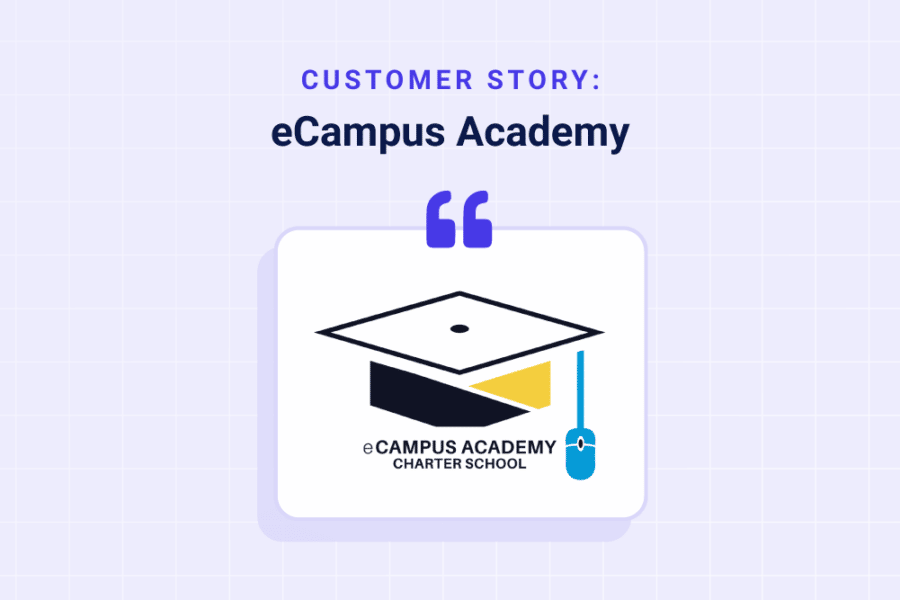
Shelby Jones is the K-12 Sales Director at Class. She’s held market-facing positions at leading EdTech companies nationally, and consults educators in their adoption of SaaS solutions for all departments. She’s passionate about start-ups, education, and technology.

Shelby Jones is the K-12 Sales Director at Class. She’s held market-facing positions at leading EdTech companies nationally, and consults educators in their adoption of SaaS solutions for all departments. She’s passionate about start-ups, education, and technology.

Creating a virtual campus that keeps students engaged and successful is no easy task.
We had the opportunity to sit down with Tracy Poches, the lead coordinator at eCampus Academy. Tracy and her team have been key leaders in defining the future of virtual education.
eCampus academy has students in pre-K through the twelfth grade. As a virtual charter school, they lead the way with innovative programming throughout the district, offering an alternative to the traditional brick-and-mortar experience. Because of this, they can truly personalize students’ learning paths…
The academy has enlisted Class to help enhance the virtual learning experience for students. Here is an excerpt of our interview with Tracy:
The students in our school can actually be both in respect to where their learning takes place. Most of our students take place in a 100% virtual environment. They do have the opportunity, if they choose, to take a few classes in the brick-and-mortar school.
Our students have various reasons why they choose to go virtual. We have some students who just didn’t find the success they needed in the brick-and-mortar school and were looking for a different alternative that fits their learning style a little bit better. Other students have more flexibility in their schedules. We have a couple of students who are downhill alpine skiers who spend part of the year in another state, and so they need the learning flexibility to make their school work with their schedule, and we were able to provide that flexibility. Other students need to have a flexible schedule because of family reasons. Their family is on a different schedule than the regular eight-hour day that most people are used to, and so they choose us to have that flexibility as well.
Our charter school did not come about as a result of the pandemic. It was in the process of being created before the pandemic, but it did become, by coincidence, became a charter in 2020.
Our program started as a way for our brick-and-mortar high school students to get some additional credits in an online environment, but they were actually in the school as they took the course. They were not at home learning, but then once we created a charter, we could actually have students in our eCampus Academy charter start to learn fully at home if they chose. We have noticed that the demand is growing for a fully virtual online experience for various reasons.
Students struggled with the way that the material is presented to them. It was a learning process for both students and teachers. The ability to share materials was sometimes cumbersome. The ability to help the students learn in a virtual environment was difficult because they just didn’t know how to do that type of learning. And so there are some frustrations with learning what to do and how to monitor their time and how to appropriately speak in a video conference.
We’re in the process of transforming the way we do virtual school, and one thing we wanted to do is be able to effectively offer both asynchronous and synchronous courses and blended courses. We wanted a way that was innovative and made the students feel like they were in a regular classroom. It needed to be engaging because oftentimes we found one of the frustrations with virtual learning was lack of engagement. Class was a platform that we could really pull the students in and have them be active participants in a virtual classroom just as they would be in a brick-and-mortar classroom.
We’ve noticed that as much as we want to see students engaged, it’s difficult for some of them to be on camera. It makes them nervous, and sometimes that can be cognitively draining. So one of the features that we really appreciate about Class is the ability to allow them to be visible to the teacher, but not necessarily visible to other classmates. It has relieved some anxiety from several students when I’ve said, “hey, I want to see you, but you can choose to not be seen by other students.” That has been so very helpful and they actually participated more because they didn’t feel self-conscious. It’s important to meet them where they’re at with their needs. The camera choices have worked well for us.
We want to make sure that these tools are not just something that’s going to cause the students more headaches than help. So that’s one thing we ask ourselves, “Is it going to integrate well with what we already have? Is it going to be user-friendly or is it going to entail a bunch of training for both teachers and for students?” We didn’t want anything that would cause a cognitive overload that can basically inhibit learning instead of enhancing learning. It needs to be easy to use so our students aren’t frustrated by the process. We also made sure this was something that was integration-friendly with the other tools that our tech-savvy students are already comfortable using.
It could be, which is why we had been looking for a collaboration-friendly platform. Sometimes when we’re in a completely online environment, students feel isolated. We want to make sure that our programs are very collaboration friendly, allowing them to talk and work with other students in their class that they may only see virtually. It needs to be something that they can easily do with other students. That’s what we really like about breakout rooms.
At our elementary level, we do a lot of virtual field trips. We also have projects where we work with businesses to complete them. You have that authentic learning experience in a project-based environment. That’s where we’re dipping our toe in that now. And so that is pretty exciting.
To learn more about how you can empower your students and teachers in online learning opportunities, visit us at class.com/k12 or schedule your demo today.

Shelby Jones is the K-12 Sales Director at Class. She’s held market-facing positions at leading EdTech companies nationally, and consults educators in their adoption of SaaS solutions for all departments. She’s passionate about start-ups, education, and technology.

Shelby Jones is the K-12 Sales Director at Class. She’s held market-facing positions at leading EdTech companies nationally, and consults educators in their adoption of SaaS solutions for all departments. She’s passionate about start-ups, education, and technology.
Get our insights, tips, and best practices delivered to your inbox

Sign up for a product demo today to learn how Class’s virtual classroom powers digital transformation at your organization.

Features
Products
Integrations